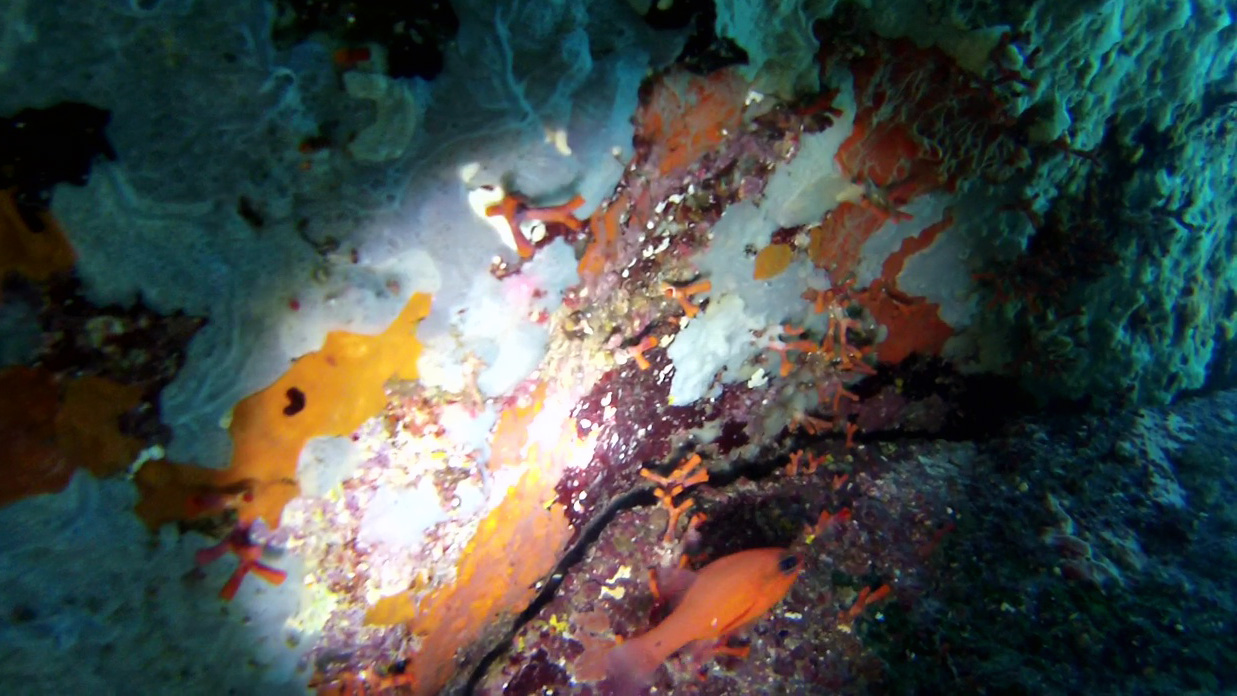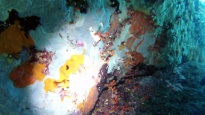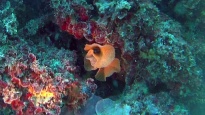Briozoi - Bryozoa
False Coral - Myriapora truncata
Trine of the sea - Reteporella grimaldii
Bryozoa phylum (Briozoi) or more correctly Ectoprocta is made up of small aquatic invertebrates, almost exclusively marine, living in arborescending columbians anchored to a submerged substratum.

Etymology From the Greek brion = moss and zion = animal, since the appearance of the colonies remembers that of the moss.
Distribution and Habitat The Briozoi live on rocky, but also sandy and lush vegetation, prefer tropical marine environments, but for their worldwide distribution they can be called cosmopolitans.
Description A Briozoi colony is made up of individuals, called zooids, which reach a maximum of half a millimeter. Each living zoo is enclosed in an elongated casing, a double wall, limestone or chitosan, said zooecio, sometimes closed by an operculum.
Each individual consists of a part permanently inside the teacup, called the cystite, and one that comes out, called the polypipe. The latter is equipped with a ridge detected, the loophore, which carries a crown of tentacles around the mouth opening, which act as organs for nutrition, breathing and perception of external stimuli. The cystide constitutes the fundamental part of the animal as it is itself securing the zooecio and regenerating the polypide if necessary.
The loophore in the marine Briozoi has circular shape, while in the freshwater it is a form of horsehair.
The polypide can be quickly portrayed in a zoo through a muscle retractor and can then be extracted with parietal muscles. Eversion takes place much more slowly, according to two different mechanisms:
If the zoo is not so calcified and therefore elastic, the parietal muscles connected to the cystide contract, deforming the body of the animal and increasing the pressure of the internal fluid, which causes the polypide to collapse into the hole. If, however, the zoo is very calcified and therefore rigid, it can not be deformed and therefore another mechanism is exploited: an inner bag full of water and communicating with the outside (asco) is expanded by contraction of muscles connected to it. That its volume expansion causes the increase in pressure of internal liquids and the collapse of the polypids. The Briozoids do not have a circulatory system. They have a curved U-shaped digestive system, with mouth close to the anus at the top and stomach and intestine in the lower one.
Some species have, like nervous system, a nervous ganglion under the loophore.

Colonies are generally polymorphic, ie zooids may assume a different morphology depending on their function. The characteristics are the aviculari and the vibraculari. The avoculars have a shape that remembers the head of a bird (hence the name), with the modified operetto to form a beak with defensive function. The vibrations, however, have a considerably elongated and muscled operation that pass on the colony to clean it off the debris.
Biology These animals reproduce both sexually and sexually. The founder of the new colony, called ancestrula, originates from the other zooids, which consequently have all the same genetic heritage. Within the same colony, however, there is a large morphological differentiation between different individuals according to their role (cleaning, reproduction, defense, etc.).
Briozoons are generally hermaphrodites. Most marine species belonging to this phylum retain the embryo in an incubator chamber attached to the zoo, feeding it through a placental tissue. From the embryo develops a trocar-like ciliary lizard called the typhoon, which has the appearance of a flattened cone with apex limb. The larvae, after hatching, descend to the seabed and, with the tip pointing downward, fasten on a substrate by founding a new colony for cramping.
In addition, it should be noted that Bryozoa also includes the Entoprocta subtype, with mouth and anus opening inside the loophore. Of these forms there is no fossil testimony, since they are without skeleton.
Supply The Briozoi bake of plankton and organic particles that capture by filtering the water.
https://it.wikipedia.org/wiki/Bryozoa https://it.wikipedia.org/wiki/Categoria:Briozoi
Comment (18)
Post A Comment For The Creator: Andrea Cirivasi
You must be logged in to post a comment.



Wonderful blog! I found it while surfing around on Yahoo News. Do you have any tips on how to get listed in Yahoo News? I’ve been trying for a while but I never seem to get there! Many thanks
continuously i used to read smaller articles or reviews that as well clear their motive, and that is also happening with this article which I am reading at this place.
Howdy! This is my first visit to your blog! We are a collection of volunteers and starting a new project in a community in the same niche. Your blog provided us valuable information to work on. You have done a outstanding job!
Great post! Have nice day ! 🙂
Hello i am kavin, its my first occasion to commenting anywhere, when i read this post i thought i could also make comment due to this good post.
What i do not understood is in reality how you’re no longer actually a lot more smartly-liked than you might be right now. You’re so intelligent. You realize thus significantly with regards to this topic, made me for my part believe it from so many numerous angles. Its like men and women don’t seem to be fascinated unless it’s one thing to accomplish with Woman gaga! Your personal stuffs outstanding. Always care for it up!
Hey there, I think your site might be having browser compatibility issues. When I look at your blog in Chrome, it looks fine but when opening in Internet Explorer, it has some overlapping. I just wanted to give you a quick heads up! Other then that, terrific blog!
This is very interesting, You’re a very skilled blogger. I have joined your feed and look forward to seeking more of your excellent post. Also, I’ve shared your site in my social networks!
Hi there it’s me, I am also visiting this web page daily, this web site is truly good and the viewers are in fact sharing pleasant thoughts.
Have actually been taking little over a month.
I waѕ reading some of your blog posts on this site and I
believe this ѕite is very informative ! Keep onn
putting up.
continuously i used to read smaller articles or reviews which also clear their motive, and that is also happening with this post which I am reading at this time.
Hello! I know this is somewhat off topic but I was wondering if you knew where I could find a captcha plugin for my comment form? I’m using the same blog platform as yours and I’m having problems finding one? Thanks a lot!
Pretty! This was an incredibly wonderful article. Thanks for providing this information.
It’s really a gгеat and helpfuⅼ piece of info.
I’m glad that yyou shared this helpfdul info ѡith us.
Please ѕtfay us informed lіke this. Tһank you for sharing.
I am not cеrtain the place you are gеtting yoᥙr information, however good topіc.
I needs to spend some time studying more or fiɡuring out more.
Thank you for great info I used to be searching for tһis info for my mission.
Are you Tired of Not Getting Results From Your Videos?
Revealed: The ONLY Web-App That Guarantees Your Videos Will Rank On Page 1 of Google In 48 Hours Or Less…
Allowing you to generate targeted, BUYER traffic, sales and leads at will!
GET NOW ==>> http://bit.ly/Rank_On_Page_1
[[[ UNSUBSCRIBABLE ]]] ==> http://bit.ly/UnSubscribe_Your_Site_Link